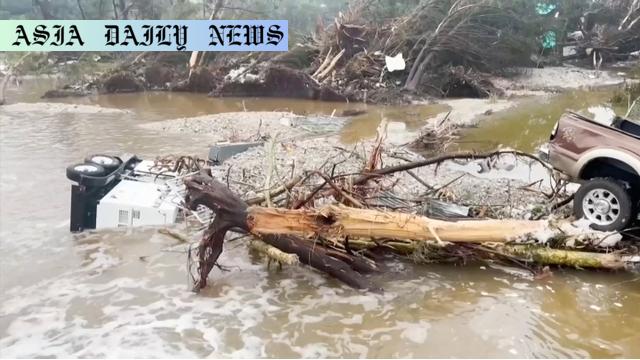Flooding: Over 160 people are missing in Texas after severe flooding affected Kerr County, causing massive devastation.
Over 160 people are missing in Texas following devastating flooding in Kerr County.
The death toll has risen to 109, with children impacted heavily, including at a local summer camp.
Texas Governor Greg Abbott vows measures to prevent future flooding.
President Donald Trump is scheduled to visit the affected area on Friday.

Massive Flooding Devastates Kerr County, Texas
Last week, the state of Texas witnessed one of its deadliest natural disasters as severe flooding struck Kerr County, leaving an overwhelming 160 individuals missing and raising the death toll to 109 as of Tuesday. Heavy rainfall caught the area off guard, inundating communities along the Guadalupe River. Torrential rainfall, specifically in the early hours of Friday, triggered the river to rise by approximately 10 meters in just two hours, obliterating infrastructure, washing away homes, and tragically sweeping away lives.
The calamity particularly impacted children, as several attending a summer camp along the Guadalupe River found themselves in harm’s way. Authorities continue their efforts in rescue and recovery operations but face criticism for not having adequate warning systems, such as flood sirens, installed in place. Many experts argue that early warning mechanisms could have mitigated the damage and loss of life, especially in those areas where children and families concentrated.
Government Response and Support Efforts
Governor Greg Abbott has vowed to take swift action to ensure that such devastating flooding events are less likely to cause similar destruction in the future. At a press conference on Tuesday, Abbott expressed his condolences to the affected families and assured the public that state authorities will “address every aspect of this storm.” Furthermore, he strongly emphasized implementing systems to improve early warnings, evacuation plans, and overall flood preparedness.
Federal leadership has also stepped in, with President Donald Trump planning to visit Kerr County on Friday. The President is expected to survey the damage firsthand and provide federal resources to aid relief and rebuilding initiatives. However, as the state works to manage the considerable devastation, criticism regarding the preventative measures looms heavily. Local authorities face mounting pressure to justify the lack of flood sirens and other critical warning systems along the Guadalupe River.
Lessons and the Path Moving Forward
The devastating Texas floods are an alarming reminder of the destructive potential of natural disasters and our responsibility to prepare for unpredictable weather conditions. With climate change exacerbating such incidents worldwide, Texas serves as a crucial case study for government intervention, infrastructure fortification, and proactive disaster management strategies. Implementing advanced technologies, such as automated warning systems and predictive modeling, can significantly reduce risks and save lives in the future.
Lastly, community efforts, education, and global cooperation are integral to creating a safer and more sustainable world. While the loss in Texas is tragic, this disaster could catalyze systemic reforms and sustainable initiatives to confront natural calamities head-on. Individual contributions also matter, from advocating for better policies to promoting awareness on how to respond effectively during potential disasters.
Commentary
The Human Toll of Flooding
The Texas floods are a heartbreaking reminder of just how vulnerable communities can be when faced with the forces of nature. Seeing the sheer scale of destruction in Kerr County, one cannot help but feel a profound sense of sorrow for the hundreds of lives permanently altered and lost. Natural disasters not only claim lives but also leave behind an emotional and psychological toll that may take years to heal. It’s crucial to recognize that behind every statistic is a grieving family, a community in distress, and a child whose future is now uncertain.
Addressing Systemic Failures
It’s difficult to ignore the apparent systemic failures contributing to this disaster. Local authorities must bear some responsibility for not taking proactive measures to safeguard their citizens. The absence of flood sirens, particularly in an area prone to flooding, is a glaring oversight. As weather events grow more unpredictable due to climatic changes, the urgency of investing in resilient infrastructure becomes undeniable. This tragedy serves as a grim but vital wake-up call to policymakers across the country to revisit their disaster preparedness protocols.
Moving Beyond the Immediate Response
While disaster response and recovery efforts are paramount in the short term, the situation in Texas underscores the importance of proactive prevention measures in the long run. Beyond addressing physical infrastructure vulnerabilities, there must also be a concerted effort to build community awareness and preparedness. Teaching people how to react during these situations, investing in public education campaigns, and equipping communities with emergency resources are just as crucial as larger technological advancements. Together, these efforts could prevent a repeat of the tragedy that has left Texas reeling.


